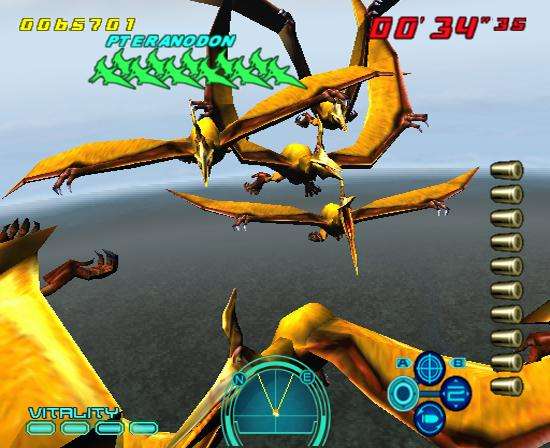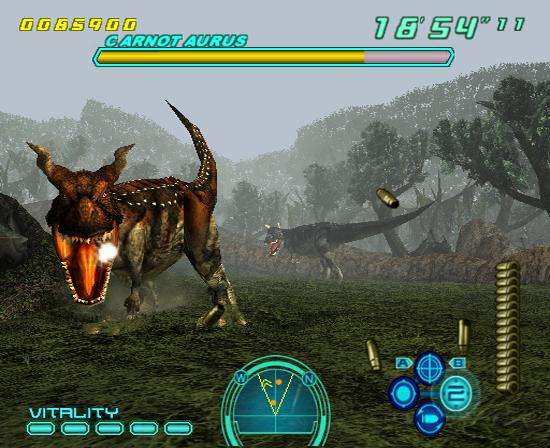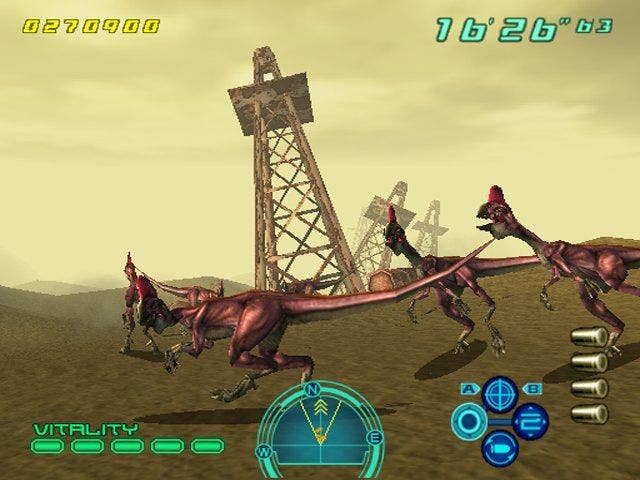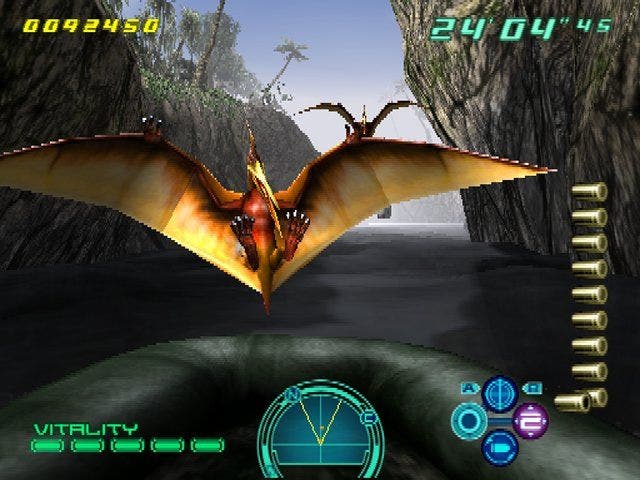Dino Stalker
Review - it's the third game in the Gun Survivor series, and easily the best yet
There are two basic rules when it comes to making light gun games. Thy plot shall be incidental, badly acted and insultingly unoriginal, and thou shalt not move from the rails beneath your feet. Capcom's Dino Stalker breaks both of these rules.

It's 1943
You're in a plane over Pearl Harbour. You've just been shot. You eject and suddenly find yourself ripped through time and space and floating through a sky filled with Pterodactyls. A futuristic machine gun appears in your hands and a bizarre electronic wristband materialises on your arm. The blasting commences.
The game's hero, Mike Wired, continues his journey through jungle, river, desert and beyond, and on the way he meets a peculiar young blonde in a tight leather outfit, and struggles to find out what happened to 1943 and why the sky looks so peculiar. All will be revealed, Mike.
Given the genre, this interesting and - dare I say it - original storyline (it is) gives the game quite an interesting set of parameters to play with. After all, do you even remember what the felons were up to in Virtua Cop? Or why you were on that train in Time Crisis 2? Or why you were shooting Sarcophagi in Confidential Mission? Of course not. It didn't matter - all that did was having something to shoot at.
However, Dino Stalker is no popgun stall. Mike Wired controls his own feet, moving where your directional pad (and A and B strafe buttons) tell him to, and wheeling round of his own accord only in the face of imminent danger. A decent plot and free roaming gunplay - an unlikely match, but one which Capcom has exploited successfully. Instead of memorising the position of a bad guy and taking him out quickly "the next time", Dino Stalker sees you moving around literally stalking dinosaurs using the radar in the middle of your heads-up display. From fleets of Pterodactyls and Raptor packs to prehistoric Crocodiles and giant twin Carnotaurus beasts, they all tumble into your sights one after another.

Chute 'em up
The game's first level sees you parachuting through the clouds and firing at Pterodactyls, and this is a good chance to get used to the radar and directional pad controls. A cone on your radar indicates your current field of view, and by employing the directional pad, you can - and must - move forwards, backwards, left and right. Before long, you're tracking the 'dactyls as they swoop across your picture.
Soon enough you're on the ground, fighting through a forest filled with (destructible) trees and a blanket of foliage, which makes the jungle in Turok: Evolution seem like the product of fifty million years of naptime. The sky is barely visible through the mesh of branches and leaves, and a mixture of thick tree trunks, fallen branches, bushes and other foliage form a barrier too thick to penetrate. This is a fixture throughout - you can trundle wherever you like, but only within a certain degree of reason. Fortunately, dinos can come at you even from areas you can't get to on foot, so there's no "edge of the level" to ignore. You know it. Your radar knows it.
It's ironic perhaps that we're applauding such a physically linear game for its supposedly free-roaming gameplay, but Dino Stalker really does challenge the traditional shoot-'em-up concept. What it does not do is perfect an alternative.

Fumble fingers
Despite Capcom's best efforts, the gameplay is still very unwieldy, and the playing position uncomfortable. There's no easy way to use the strafe buttons and directional pad whilst firing, and juggling your fingers to keep yourself moving is frustrating, particularly during boss fights where the target keeps on coming. The addition of a sniper mode is a nice idea - pressing A and B simultaneously takes you there and lets you zoom in and out - but spend more than a few seconds with your eye on the horizon and you'll find the timer ticking perilously close to zero, or worse, you'll find yourself jumped by a sneaky Raptor.
With the timer constantly ticking down, you find yourself rushing through the environment; never quite sure of how much there is left to do, or what's coming next. If you stalk quietly through each level picking your enemies off one by one, you won't even make it past the halfway mark, and this is a missed opportunity for Capcom - Dino Stalker is a lot more fun when you're, ironically, stalking!

Visual splendour
Like just about every PS2 shooter to date, Dino Stalker looks quite nice, but there are some issues of clarity and animation to address. For a start, there's quite a lot of fog on the horizon, which sets our cheap programming trick klaxon buzzing, and the dinos, though they exist in great numbers and rarely drag the game from its standard 60 frames per second, do look rather bland. With the exception of the Carnotaurus and his brother, who both look like the T-Rex from Jurassic Park on a bad hair day. The simple dinos and short-range fog do add to the suspense, and have allowed Capcom to introduce some stunning environments. The aforementioned jungle is an impressive sight, and the riverboat ride offers a surprisingly good interpretation of choppy water and rocky shores. A handsome setting is good for the level design too, although in most cases the actual layout of the levels is incredibly simple, with corridors through scenery linking big clearings, and the occasional bridged gap or environmental obstacle. But on the whole it works on account of the visuals, and the variety and distribution of power-ups.
Yes, power-ups - the mainstay of any decent shooter. In addition to his standard firearm, Mike can also pick up shotguns, machine guns, bazookas and other improved firepower, although he can only carry one at a time. A degree of strategy quickly emerges though as Mike has to manage his arsenal and save the best items over for boss encounters.
Short lived
The only serious thing to be said against Dino Stalker concerns the length. Like most light gun titles, it's over before you've really started to get comfortable, but to its credit, the game is brimming with extras. Once you've polished off the single player game, for example, a two-player mode is unlocked, which definitely provides incentive to persevere on your lonesome. Furthermore, your performance on each level is rated on a scale of D through A with a special bonus award for stunners - and your points score is based on your physical state and proficiency behind the sights, so there's lots of headroom even after a few playthroughs.
The real question, though, is whether it's still fun when you're playing it the third or fourth time, and that really depends on your relationship with the control system. If you can juggle the buttons and move unrestrained then you'll find Dino Stalker refreshing and replayable, but if you find the D-pad more of a hindrance than a heart warmer, then it might make sense to leave this one on the shelf.

